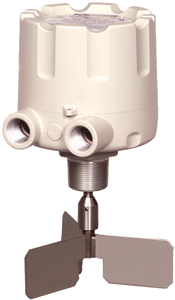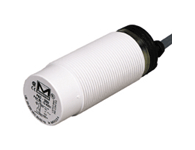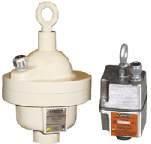| |
| |
|
| |
 |
| |
Rotary Paddle
Bin Monitor
Monitor's line of rotary paddle bin monitors consists of
the most reliable, rugged and economical point level control
sensors available for detection of dry bulk materials. These
easy to install units are proven performers in a wide variety
of bulk materials. Monitor's paddle units can be used to eliminate
bin overflow, maintain a predetermined material level, indicate
plugging of conveyors and pneumatic lines or provide any of
a number of level control functions. Unlike many other available
paddle units, Monitor's paddle level indicators incorporate
a feature that automatically shuts off the motor of the unit
when the paddle is in a stalled position, which both extends
the life of the motor and minimizes maintenance.
Principle of Operation:
The operation of the paddle level control products is quite
simple. The unit is installed through the wall of the vessel,
so that the paddle protrudes inside the vessel. A small electric
motor drives a paddle which rotates freely in the absence of
material.
When the paddle is impeded by material,
the motor rotates within the housing which triggers two switches.
The first switch is a “dry” electrical contact
closure that is available to control a process function or
alarm circuit. The second switch cuts the power to the motor,
preventing a locked rotor condition, thus extending motor life.
This also activates the signaling device which is wired through
that same motor switch. When the material level drops, the
loaded stretched tension spring returns the motor to its original
running position and the unit is reactivated.

MODEL KA - This model is ideal for use in
standard applications with a wide variety of materials.
MODEL KAX - This model incorporates all the
features of the KA model, but is specially designed to meet hazardous
location standards.
Fail-Safe Rotary
Paddle Bin Monitor
The SafePoint bin monitor provides the ultimate in performance
wherever critical continuous operation must be ensured. Detection
of both material presence and its own operational status is
performed on a continuous basis. The SafePoint level sensor
monitors its electrical and mechanical operating condition.
This, in conjunction with separate outputs provided for material
sense and unit status (fault conditions) make the SafePoint
a “truly” fail-safe device.
While the SafePoint bin monitor is an evolution in rotary
paddle technology, it continues to use tried-and-true Monitor
operating techniques. Unlike many other available units, the
SafePoint incorporates a feature that automatically shuts off
its motor when the paddle is in a stalled condition. This extends
the life of the unit and minimizes maintenance.
Principle of Operation:
The
operation of the SafePoint® rotary paddle bin monitor
uses Monitor’s magnetic sensing technology to detect
both material presence and operational status of the unit.
This method is simple and more reliable than that used by other
brands. The unit is installed through the wall of the vessel
so that the paddle protrudes inside the vessel. A small electric
motor drives the paddle, which rotates freely in the absence
of material.
The rotation of the unit’s shaft is continuously monitored
by detection of a magnetized rotating disk (patented). When
the paddle is impeded by material, the shaft rotation stops.
The motor rotates within the housing and magnetized sections
of the motor mounting plate are detected (patented). Use of
these magnetic sensing techniques eliminates problems that
may occur with fouling of the optical systems used by other
brands.
The built-in microcontroller performs self-diagnostics and
monitors both shaft and motor mounting plate rotation. This
allows the SafePoint to easily distinguish between material
presence and any electrical and mechanical failure of the unit.
When material presence is detected, the SENSE relay changes
state and the drive motor is de-energized to extend motor life.
This output is available to control a process function or alarm
circuit. When the material level drops, a tension spring returns
the drive motor to its original running condition and is reactivated.
A unit failure is detected by sensing a lack of shaft rotation
while material presence has not been detected by rotation of
the motor mounting plate. In a failure condition the independent
FAULT relay will change state indicating that an error condition
exists. Monitoring the state of both the SENSE and FAULT relays
provides the most flexibility for control and fail-safe monitoring.

RF Capacitance - MK-2 and MK-2e
TrueCap® RF capacitance sensors offer cost-effective
point level monitoring with reliability you can count on. Monitor’s
complete line, which features models MK-2 and MK-2e, provides
you with the most affordable solution for your application.
Monitor’s RF capacitance probes are designed to provide
a high level of sensitivity, stability and durability for powder
and bulk solids applications, as well as liquid and slurry
applications. Monitor’s two-year warranty stands behind
every TrueCap sensor.
Principle of Operation:
A
radio frequency is applied to the probe and is continually
analyzed to determine the influence caused by the surrounding
environment. As material contacts the probe, the radio frequency
shifts indicating an increase in capacitance (C). The active
probe of the unit and the vessel’s wall make up the two
plates (A=area) of a capacitor which are separated by a fixed
distance (d). The probe’s insulator and surrounding air
provide the dielectric material (with dielectric constant “K”).
As the air (K=1.0) is displaced with any other material (K > 1.0),
the capacitance effect (C) is enhanced, thereby changing the
application’s impedance. This influence is measured within
the circuitry and compared to a reference established by the
sensitivity setting. The setting determines how much influence
must be present before the output changes.
The driven shield section of the probe enables the circuitry
to ignore product build-up on the probe that would otherwise
cause false sensing. The driven shield is activated with the
same radio frequency potential as the sensing probe. Since current
can not flow between identical potentials, the driven shield
blocks current flow from the active probe to the vessel wall
through the material build-up, thereby eliminating the sensing
of the material build-up.

Proximity Switches
The models PAC-30U and PDC-30 proximity switches are solid
state point level devices used to detect the absence or presence
of bulk solids. The compact configuration makes this product
ideal for tight spaces or low cost level detection. As material
comes in contact with, or in close proximity to, the PAC-30U
or PDC-30, an internal solid state switch is activated. The
PAC-30U is AC operated (20-265 VAC) and is universal in that
it is switch selectable for either normally open or normally
closed operation. The PDC-30 is DC operated (10-40 VDC) and
is available in either PNP or NPN configuration, each of which
can be wired in either a normally open or normally closed operation
mode.
Principle of operation:
The
PAC-30U and PDC-30 are RF capacitance-type level controls,
which operate by detecting the electrical effect of the surrounding
material such as air, plastic pellets or powders. A radio frequency
is applied to the proximity switch sensing region and is continually
analyzed to determine the influence of the surrounding environment.
Since all materials have dielectric constants and conductance
values that are different from that of air, the resultant impedance
seen by the radio frequency changes whenever material approaches
or contacts the sensing region. This influence is measured within
the circuitry and compared with the reference point set by the
sensitivity adjustment, which determines how much influence must
be present before the output changes.

Vibratory Probe - PZP
The PZP vibratory level sensor provides reliable point
level detection in a wide variety of process control applications
within the powder and bulk solids market.
The PZP offers many advantages over alternative technologies.
The vibrating probe principle eliminates problems associated
with temperature, humidity and material changes, while providing
state-of-the-art electronic reliability and accuracy that requires no
calibration. The unique single-prong probe design
eliminates material packing problems and false signaling typically
associated with the dual-prong "tuning fork" design.
The PZP's ability to detect a wide variety of material densities,
including very lightweight materials, makes it an attractive
solution for many applications.
Principle of Operation:
The
PZP utilizes piezoelectric technology to create a vibration
and then constantly monitors the presence or absence of that
vibration. Two piezoelectric crystals are located in the base
of the probe. A signal is applied to one crystal at the frequency
corresponding to the probe's self-resonance. The electrical
excitation causes physical deformation of the crystal resulting
in probe vibration. With no material present, the vibration
of the probe is felt by the second crystal. This vibration
causes physical deformation of the second crystal which generates
a voltage to be analyzed by the electronic circuitry. With
material present around the probe, the vibration is dampened,
thereby minimizing the voltage generated by the second crystal.
The output voltage is analyzed by the circuitry and the relay
status changes accordingly.

STANDARD PROBE
The standard probe is approximately 7" (178mm) in length and is suitable
for both top and side mount applications. It mounts to the vessel via a 1-1/2" mounting
gland.
PIPE EXTENSION PROBE
For high and low level applications that extend beyond the length of a standard
probe, Monitor offers a pipe extension probe. This configuration is intended
for top mount applications only. The extension is constructed of 1" NPT
stainless steel pipe which provides structural strength and affords a means
to secure the assembly to the vessel. Available in lengths up to 12' (3.6m),
this unit is factory sized to the customer's specifications.
FLEXIBLE CABLE EXTENSION PROBE
The cable extension configuration extends the detection length beyond the standard
probe length. This self-contained unit is for use in top mount applications
and can be used for both high and low level detection. A polyurethane sheathed,
steel rope reinforced cable is used for the extension, and is available in
lengths up to 20' (6.1m). The unit mounts to the top of the vessel via a
1-1/2" mounting gland.
HIGH TEMP/REMOTE ELECTRONICS
This configuration offers a split-architecture design that removes the electronics
to a remote mounting location away from the vessel. The furnished cable allows
for a 6' (1.8m)separation between the probe and the remote electronics. This
unit offers a reliable solution for applications that involve high temperatures
or in vibrating vessels that reduce the reliability of most level sensors. The
probe can be top or side mounted for use in high or low level applications. For
top mount applications, the probe can be ordered with a pipe extension (see above).
Vibratory Probe - VibraRod™
The VibraRod™ vibrating rod
sensor provides reliable point level sensing in a wide variety
of applications within powder and bulk solids markets. The
vibrating probe principle utilized by the VibraRod overcomes
typical application difficulties associated with changes
in material, electrical dielectric constant, temperature
or humidity while providing reliable solid state electronic
circuitry that requires no calibration. The VibraRod has
the ability to detect a wide range of material densities.
The VibraRod line of vibrating rod point level sensors is
offered in standard length, cable extension or pipe extension
versions. The standard length version extends into your vessel
approximately 9 inches (235 mm). The pipe extended version
can be used to extend the measuring rod up to 120 inches (3
m) and the cable extended unit can be used to extend the probe
up to about 65 feet (20 m). Each version can be provided with
either a plastic or aluminum housing. VibraRod units are provided
with local indication using a bi-color LED and a traditional
relay output.
Principle of Operation:
The
VibraRod™ line of point level sensors is a mechanical
resonance system that is excited and kept in resonance by the
sensor's electronic circuitry. Two piezoelectric crystals are
mounted on the internal portion of the probe’s base.
An electrical signal is applied to one crystal at the frequency
corresponding to the probe’s self-resonance. This electrical
excitation causes physical deformation of the crystal which
in-turn creates probe vibration. When no material is present
around the VibraRod's probe, the vibration of the probe is
received by the second crystal. This causes physical deformation
of the second crystal which generates a voltage analyzed by
the electronic circuitry. With material present and surrounding
the probe, the vibration is dampened so that the second crystal
is not able to generate as high a voltage as when no material
is present. The electronic circuitry senses this change and
the relay output changes accordingly.

STANDARD PROBE
The standard probe is approximately 9-1/4 inches (235 mm) in length and is
suitable for both top and side mount applications. It mounts to the vessel
with a 1-1/2" NPT or BSP connection.
PIPE EXTENSION PROBE
For high and low level applications that extend beyond the length of the standard
probe, the VibraRod™ can be provided with a pipe extension probe. This
configuration is intended for top mount applications only. The extension
is constructed of 1" stainless steel pipe, which provides structural
strength and affords a means to secure the assembly to the vessel. The pipe
extension probe is available in lengths up to 10 feet (3 m) in length. The
unit mounts to the vessel with a 1-1/2" NPT or BSP connection.
CABLE EXTENSION PROBE
The cable extension probe configuration extends the detection
length beyond the standard and pipe extension probes. This version
of the VibraRod level sensor is for use in top mount applications
only and can be used for both high and low level applications.
A polyethylene (PE) coated steel reinforced cable is used for
the extension and is available in lengths up to 65 feet (20 m).
The unit mounts to the vessel with a 1-1/2" NPT or BSP connection.
Diaphragm Switches
Monitor's line of BINATROL® diaphragm
bin monitors consists of economical, reliable, and durable
point level controls for point level detection of dry bulk
materials. The units can be used to eliminate bin overflow,
maintain a predetermined material level, indicate plugging
of chutes or conveyors or provide any of a number of level
control functions. The flush mount, non-intrusive BINATROL
units are ideally used when vessel size or internal clearance
is limited, or where protrusion into a vessel is not acceptable.
All installation and servicing, including diaphragm replacement
and sensitivity adjustment, can be done from outside the
vessel. These products are not normally used with materials
which are very light, sticky or of large particle size.
Principle of Operation:
A
diaphragm bin monitor provides level indication by detecting
pressure applied by the bulk material to the sensing diaphragm.
The unit is installed to a vessel wall so that the diaphragm
is exposed to the material to be sensed. As material contacts
the diaphragm, a force is exerted through the diaphragm to
a pressure plate within the bin monitor. Physical deflection
of the pressure plate activates an internal switch which is
user accessible for signaling alarms, lights or PLC inputs.
When material recedes from the diaphragm, a light duty spring
returns the pressure plate and internal switch back to their
original positions.

MODEL G
The Model G is the most basic BINATROL® diaphragm bin monitor. It provides
accurate point level control on most bin types for products ranging from pellets
to fine powders.
MODEL GX
The Model GX offers all the features of the Model G, but is specially designed
to provide dust-ignition proof protection. This model should be used in applications
which require Class II dust-ignition proof approval.
MODEL GX-SS
The Model GX-SS is the dust- ignition proof version of the Model G with a type
321 stainless steel diaphragm. This type of diaphragm provides corrosion resistance
when used with corrosive materials such as fertilizer or added protection in
abrasive applications. All other features are consistent with Models G and GX.
Tilt Switches
Monitor’s line of tilt switches are economical, trouble-free
point level controls available for detection of dry bulk materials.
The units can be used as high level indicators to eliminate
bin overflow or to control levels in open piles. In addition,
the tilt switches are useful in determining over or under-load
on conveyor belts. The simple yet efficient internal construction
(one moving part) provides indication when unit is tilted at
a 17° angle throughout the complete 360° of axial arc.
Each tilt switch includes a threaded bore for attaching extension
actuators which can increase sensing repeatability and protect
the tilt switch from direct contact with coarse material. Monitor
offers two different models of tilt switches, each suited to
satisfy different application requirements.
Principle of Operation:
A
tilt switch provides indication by detecting the angular position
of the tilt switch enclosure. Typically the unit is suspended
above the material to be sensed. Internally, a steel ball centers
itself over a switch resulting in switch actuation. As rising
material contacts the tilt switch (or the extension actuator)
the enclosure begins to tilt. When the enclosure body is tilted
at 17°,
the steel ball rolls off center, deactivating the switch.
As material falls away from the switch enclosure body (or
the extension actuator) and the unit becomes upright, the
ball returns to its original centered position, once again
causing switch actuation. The change in the internal switch
status is user accessible for signaling alarms, lights, or
interfacing with a PLC.

MODEL TC-1
Model TC-1 is
a heavy-duty, weather-proof tilt switch constructed from cast
iron. It is ideally suited for applications where heavy coarse
materials are handled (i.e. >45lb/ft³ ; >720kg/m³ or
particle sizes exceeding 2in; 50mm). Typical application materials
include coal, ore, rock, aggregate, and sand.
MODEL TC-3X
Model TC-3X is
a light-duty tilt switch constructed from cast aluminum. It
is ideally suited for applications where relatively light weight,
moderately sized materials are handled (i.e. 15-60lb/ft³;
240-960kg/m³ or
particle sizes less than 2in; 50mm). Typical application
materials include grain, feed, plastic pellets, and pet food.
The TC-3X has a dust-ignition proof approval rating and therefore
can be used in applicable hazardous location environments.
|
|